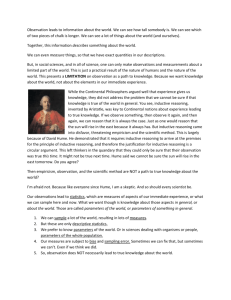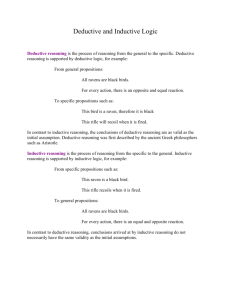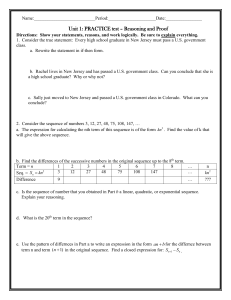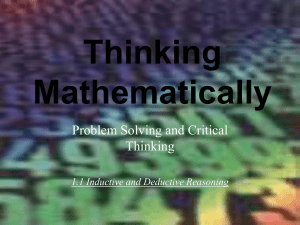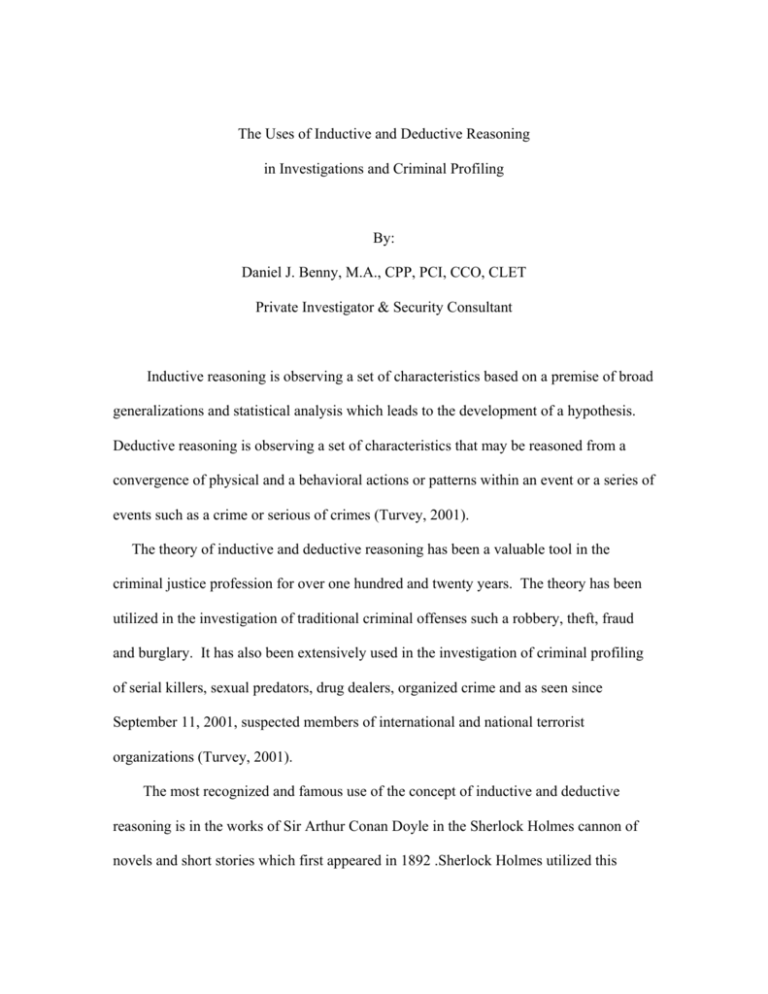
The Uses of Inductive and Deductive Reasoning
in Investigations and Criminal Profiling
By:
Daniel J. Benny, M.A., CPP, PCI, CCO, CLET
Private Investigator & Security Consultant
Inductive reasoning is observing a set of characteristics based on a premise of broad
generalizations and statistical analysis which leads to the development of a hypothesis.
Deductive reasoning is observing a set of characteristics that may be reasoned from a
convergence of physical and a behavioral actions or patterns within an event or a series of
events such as a crime or serious of crimes (Turvey, 2001).
The theory of inductive and deductive reasoning has been a valuable tool in the
criminal justice profession for over one hundred and twenty years. The theory has been
utilized in the investigation of traditional criminal offenses such a robbery, theft, fraud
and burglary. It has also been extensively used in the investigation of criminal profiling
of serial killers, sexual predators, drug dealers, organized crime and as seen since
September 11, 2001, suspected members of international and national terrorist
organizations (Turvey, 2001).
The most recognized and famous use of the concept of inductive and deductive
reasoning is in the works of Sir Arthur Conan Doyle in the Sherlock Holmes cannon of
novels and short stories which first appeared in 1892 .Sherlock Holmes utilized this
theory to not only solve crime but to build a profile of an individual based on
observations of the facts and then building an hypotheses around the facts. When
Holmes first met Dr. John Watson he used this theory to make a determination that
Watson had an injury which was recently received from being in combat in Afghanistan.
Holmes deducted by the way Watson carried his shoulder that he had recent wound.
Because of the way Watson carried himself he had the air of a military man and his face
was tanned. Holmes correctly deduced that Watson was an Army Surgeon recently back
from battle in Afghanistan, a location in which the British Army was currently engaged
in battle in which an individual could have obtained such a tanned complexion (Doyle,
1882).
The Holmes stories so effectively dramatized the theory of inductive and deductive
reasoning that they are used today at the Metropolitan Police Department, Scotland Yard,
at their detective school located at the Peel Academy outside of London. They are used
to teach the concept of inductive and deductive reasoning in the criminal justice
profession.
The first known use of the theory of inductive and deductive reasoning in criminal
justice was during the same time period of the Sherlock Holmes stories. In 1888 a series
of gruesome murders occurred in the east end of London known as White Chapel. They
became known as the White Chapel murders perpetrated by the Victorian criminal known
as Jack the Ripper. The crime, which to this day remain unsolved, were so revolting to
society that the Metropolitan Police and the City of London Police tried franticly to solve
the case and to identify Jack the Ripper.
Regional Police Surgeon Doctor George B. Phillips of the Metropolitan Police first
utilized this theory in the examination of the physical evidence found at the crimes. This
evidence included the nature of the wounds, the location of the crime and commonalities
among the victims of Jack the Ripper. The theory was used in an attempt to identify the
suspect known as Jack the Ripper and to anticipate when and where he might attack his
next victim. Unfortunately the individual known as Jack the Ripper was never identified
and after the last documented White Chapel murder he was never heard from again.
The theory was utilized to identify numerous suspects but the results have never been
conclusive (Turvey, 2001).
During World War II the Office of Strategic Service (OSS), forerunner of the Central
Intelligence Agency, utilized the theory of inductive and deductive reasoning in the form
of profiling. They attempted to profile Adolph Hitler in an effort to determine the impact
of the war on his decision making. It was used to anticipate how he would direct the
action of his military (Turvey, 2001).
In 1956 these theories were utilize by Doctor James A. Brussel in New York City in
an effort to identify and apprehend an individual known as the “Mad Bomber”. This
individual terrorized the residences of New York City throughout the 1940s and 1950s by
bombing building throughout New York City (Turvey, 2001).
The use of this theory by Doctor Brussel was successful in assisting the New York
City Police Department in identifying George Metsky as the bomber which lead to his
arrest and successful prosecution. This case provided an opportunity to promote the
theory within the criminal justice community (Turvey, 2001).
Based on the success of the use of the theory in criminal justice cases, FBI Special
Agent Howard Tenten developed a behavioral science program in 1970 at the FBI
National Academy located in Quantico, Virginia. The uses of the theory by the FBI
behavioral science unit lead to a series of successful investigations (Turvey, 2001).
Perhaps one of the most famous members of the FBI behavioral sciences unit was John
Douglas. He began his tour with the unit in 1978. John Douglas came to national
attention in the 1970s when he used the theory in the Atlanta, George killings of
numerous young black males. In that case he was able to accurately profile the killer of
the young men. His profile of the killer being a black male with an interest in police
matters was met with skepticism from the predominately black Atlanta Police
Department, chief and mayor, but the profile provided by John Douglas in this case
matched the suspect and lead to his arrest (Douglas, 1995).
Douglas not only used this theory in the arrest of the suspect but also utilized it to aid
the District Attorney in the conviction of the defendant by providing an insight on how he
would react on the witness stand and what question might lead to an admission by the
defendant. With the assistance of John Douglas the defendant made an admission of guilt
on the witness stand which along with the physical evidence, lead to his conviction
(Douglas, 1995).
The use of the theory of inductive and deductive reasoning has become widespread
within the criminal justice community. It continues to be utilized for the investigation of
traditional criminal activity such as serial killers, organized crime and the drug cartel.
The new use of the theory in criminal justice is in the area of espionage investigation and
counterintelligence, as well the investigation of terrorism and with the counter terrorism
efforts underway by federal, state and local law enforcement and intelligence agencies.
In addition to the use of the theories by the law enforcement aspect of the criminal
justice system, private and corporate security is also using this method for the
investigation of fraud and internal theft within their organizations.
Perhaps the most controversial uses of inductive and deductive reasoning are in the
area of criminal profiling in relation to the current terrorist threat against the United
States from radical Islam. When it comes to a situation where the primary suspects of a
criminal act are comprised of members of a certain ethnic or religious group and this is
determined by the theory of inductive and deductive reasoning as it is applied to criminal
justice, members of the suspect community and civil rights organizations begin to view
the use of this theory as racial profiling and a violation of individual rights.
While there is a distinct difference between the use of the inductive and deductive
theories in criminal profiling and racial profiling, the distinction can become blurred in
the minds of the members of the target group. It may be an lack of understanding on how
the theory is utilized, social activism or members of a terrorist organization attempting to
thwart a legal and effective tool which may identify them.
Regardless of these challenges the criminal justice profession will continue to utilize
this effect and proven theory of inductive and deductive reasoning to reduce and prevent
crime and identify the suspects of a variety of criminal activity which threatens our
country and way of life.
Inductive reasoning is the use of an inference that is established through a set of
observations leading to a generalization which is known as a premise. The premise is a
working assumption. While a working assumption has been established it does not mean
that it is an automatically valid assumption (Turvey, 2001).
One needs to remember that propositions are only a basic building block of
argumentation reasoning. A proposition is a conclusion that can be argued on the basis of
one or several premises. The premises may or may not be valid but will lead to an
inductive argument and the development of hypotheses (Turvey, 2001).
There are several types of inductive arguments that are more prevalent in the criminal
justice profession. The first argues from the specific to the general and is known as
inductive generalization. A conclusion would be formed about observations and
characteristics of a single individual or single event. It may also include the
characteristics and observations of several individuals or events. Based on that
information a preliminary generalization is made concluding that similar individuals or
events that are seen or encountered in the future will exhibit the same observations of the
originally documented characteristics (Turvey, 2001).
A statistical argument is also used in the criminal justice profession. Since it is
statistical, truthfulness of this type of argument is based on probability. It may appear to
be sound reasoning and may appeal to a common sense attitude but they are inherently
problematic and unreliable (Turvey, 2001).
An example of an inductive argument with appropriate qualifications, based on the
fact that both the premises and the final conclusions must correct would be as follows:
Premise: Most known terrorists are males. Premise: Most known terrorists are from the
Middle East. Premise: Most known terrorists are Islamic. Conclusion: It is likely that a
terrorist attack will be carried out by a male of Middle Eastern origin who is Islamic.
The same example with inappropriate qualifications would appear as follows:
Premise: Most known terrorist are males. Premise: Most known terrorists are from the
Middle East. Premise: Most known terrorists are Islamic. Conclusion: All terrorist
attacks will be carried out by a male of Middle Eastern origin who is Islamic. This type
of inappropriate conclusion occurs in the criminal justice profession to the determent of
the use of this theory of inductive reasoning (Turvey, 2001).
The advantages of this theory it that it is easy to apply and does not require specialized
forensic knowledge, training or education in the study of behavior. It also allows the
criminal justice professional to develop a theory in a relatively short period of time
(Turvey, 2001). This can be critical and save lives if the case involves a serial killer or
possible terrorist attack.
There are of course disadvantages with the most oblivious being that the data or
information collected is limited as it is based on generalizations from a limited sample
population. If the sampling is not large enough or was not conducted correctly there will
be a lack of reliability and consistency with the results (Turvey, 2001).
Another disadvantage to the criminal justice field is that the sampling is limited to
known suspects or offenders who have been identified in the past. This leaves a missing
dataset as the most skilful or intelligent criminal have avoided detection and
apprehension over an extended period of time and therefore are not counted as part of the
overall study (Turvey, 2001).
The most serious concern and disadvantage is that with the generalization in the
inductive process there may be inaccuracies. Such inaccuracies may lead to the
implication of an innocent individual or group of individuals. The inductive reasoning
can be nonspecific and unqualified in their final conclusions (Turvey, 2001).
Deductive reasoning involves the argument that if the premise is true then the
conclusion is also true. Within deductive reasoning the conclusion are arrived at through
the given premises. The reasoning moves from the general to the specific when utilized
by the criminal justice profession. As applied to criminal justice the offender’s behaviors
and or patterns would be suggestive of critical offender characteristics (Turvey, 2001).
Deductive reasoning may appear as follows: Premise: The offender disposed of the
body of his victim at remote area along the coast. Premise: SUV tire tracks were found
at the disposal site of the body. Conclusion: If the tracks made by the tires belong to the
offender, then he has access to the SUV and the ability to travel to the remote area where
the body was disposed of.
Deductive reasoning in criminal justice includes looking at a set of characteristics of
the offender that are reasoned by the convergence of all of the physical evidence in the
case as well as the behavioral evidence patterns within that case or a serious of related
cases and crimes (Douglas, 1995).
The scientific basis for the inductive and deductive reasoning theory as utilized by the
criminal justice profession was drawn from several areas of science over a period of
many years as the theory was developed and adapted for use by the criminal justice
community.
One of the scientific bases of the theory came from forensic science. More
specifically, forensic pathology was applied to the theory. Forensic pathology is the
category of the medical profession that applies the concept of and principles of medical
knowledge to the law and criminal justice profession (Turvey, 2001).
In forensic pathology it is vital to document and correlate the interaction between the
victim, their environment and the cause and manner of their death. The goal of the
outcome is to be able to link this documented information in the form of evident to the
suspect in the crime and to be able to prove such documented facts in a court of law. If
done correctly the results will be a conviction of the suspect in the case and the resolution
of the crime (Turvey, 2001).
The area of behavioral science also plays a major role in the scientific bases for
inductive and deductive reasoning as practiced in the criminal justice profession.
Psychiatry is the area of the medical profession which deals with the concept of diagnosis
and treatment of various mental disorders. Forensic psychiatry is the study of mental
illness and or behavioral patterns with the application to the law and the criminal justice
field (Turvey, 2001).
This information is elicited by face to face clinical interviews, studies of the history of
individuals and the application of tested and validated personality measures and testing
(Turvey, 2001).
Inductive and deductive reasoning, while being associated with criminal justice in
the minds of most of the public, had its foundation based on the concept of empiricism or
logical positivism. This theory of thinking and research was derived from the
philosopher and mathematician August Comte. In modern times the philosophers
Wittgenstein, Russell and Moore expanded this doctrine. They move more in the
direction of traditional science in that they felt that knowledge could be attained only
through the methodology of scientific verification (Indick, 2002).
The assumptions of logical positivism state that knowledge can be found in direct
observation and through deduction. It is felt this is the only method to be truly free from
metaphysical overtones and the influence of personal bias. The networking of science is
also one of the major goals of logical positivism (Keeler, Shemberge & Zaynor, 1988).
One of the major goals of the proponents of the use of logical positivism and of
inductive and deductive reasoning in recent times has been to give the theory validly and
recognition within the scientific community. There is a struggle on the part of those in
the social science profession to include the criminal justice profession to be recognized at
the level of their colleagues in the area of physical science. One of the criticisms is that it
is difficult to be an exact science when it comes to social science areas. It is like the
shadows on the cave wall described by Plato in that social science can never be as precise
as the physical sciences (Retrieved October 17, 2005, from
http://weblinks1.cpnet.com.library.capella.edu).
Another criticism is that positivism or inductive and deductive reasoning in the
criminal justice profession attempts to turn knowledge into a universal criterion of
rationality implying that it is not grounded in fact (Fuchs, 1993). Such criticism comes
from the forensic science area of the criminal justice community. When working with
physical evidence such as fingerprints and DNA, most results are clear cut, black and
white with a definitive answer. Unlike inductive and deductive reasoning as is used in
criminal profiling, the end results are not always what was envisioned or hoped it would
be. It is not an exact science and does not give the definitive answer that in most cases is
derived from the forensic science aspects of the criminal justice profession (Bartol &
Bartol, 2005).
It is evident the use of inductive and deductive reasoning has a basis in science and in
most cases has been accepted by members of the criminal justice establishment as a
legitimate science to be utilized within the criminal justice profession. It has even been
accepted by the courts for the purpose of providing expert witness testimony (Douglas,
1995).
Another area that is validating the theory is that numerous colleges are now offering
courses in criminal profiling in which the theory of inductive and deductive reason is
utilized in the study of criminal justice (Douglas, 1995). One of the first institutions of
higher education to offer a course of study on the subject was Pennsylvania State
University at the main campus located in State College, Pennsylvania. The program
began in 1990 and has grown and continues to be successful to this day
(Bartol & Bartol , 2005).
While the inductive and deductive theory utilized in the investigation of crimes and
criminal profiling may never meet the standards or level of success as seen in the forensic
science, it has become an accepted process (Douglas, 1995).
Based on its historical development, the fact that it is based in science, its acceptance
in college curriculums around the country and the successes seen in the field of criminal
justice, inductive and deductive reasoning will continue to play a vital role in the criminal
justice profession long into the future.
References:
Bartol, D. & Bartol, A. (2005). Criminal profiling a psychosocial approach. Upper
Saddle River, NJ: Pearson/Prentice Hall
Douglas, .J. (1995). Mind hunter. New York, NY: Simon & Schuster Inc.
Doyle, C. (1882). A study in scarlet. London, UK: Doubleday
Fuchs, S. (1993). Three sociological epistemologies. Sociological Perspectives, 36. (1),
23-44.
Indick, W. (2002). Fight the power: the limits of empiricism and the cost of
Positivistic
rigor. Journal of Psychology, 136 (1), 21-37.
Keeley, S.M., Shemberge, K.M. & Zaynor, L. (1988). Diseseration research in clinical
psychology: Beyond positivism? Professional Psychology: Research and Practice,
19 (2), 216-222.
Reamer, F. (1992). The place of empiricism in social work. Journal of Social Work
Education. Retrieved October 17, 2005, from
http://weblinks1.cpnet.com.library.capella.edu
Turvey, B. (2001). Criminal profiling. San Diego, CA: Elsevier Academic Press
Daniel J. Benny is a Ph.D. Candidate in Criminal Justice at Capella University, holds an
M.A. in Administration from Vermont College of Norwich University and is a Graduate
of the U.S. Naval War College. He is a Certified Protection Professional, Professional
Certified Investigator, Certified Confidentiality Officer and Certified Law Enforcement
Trainer. He is a former Naval Intelligence Officer and operates as a Private Investigator
and Security Consultant from Harrisburg, Pennsylvania.



